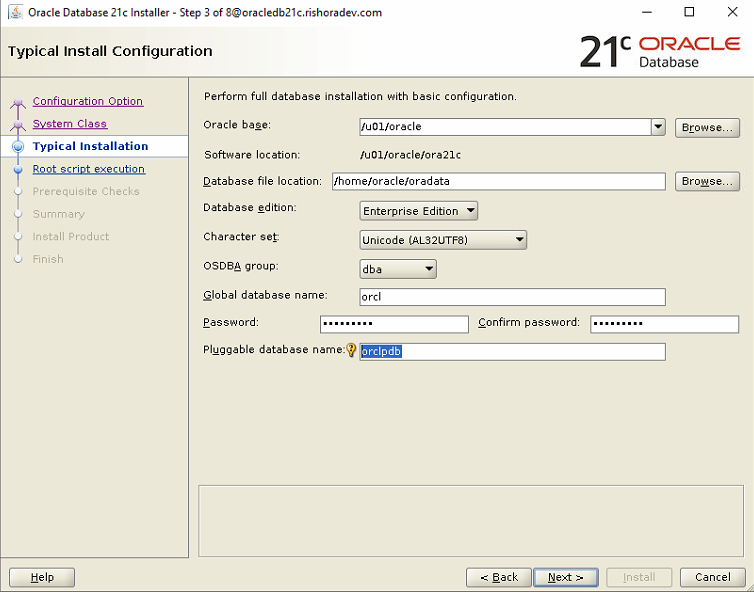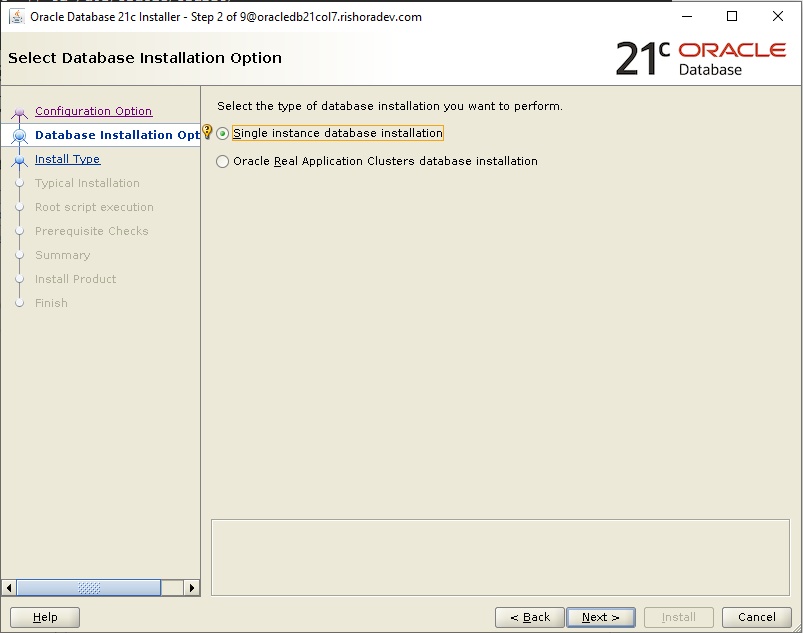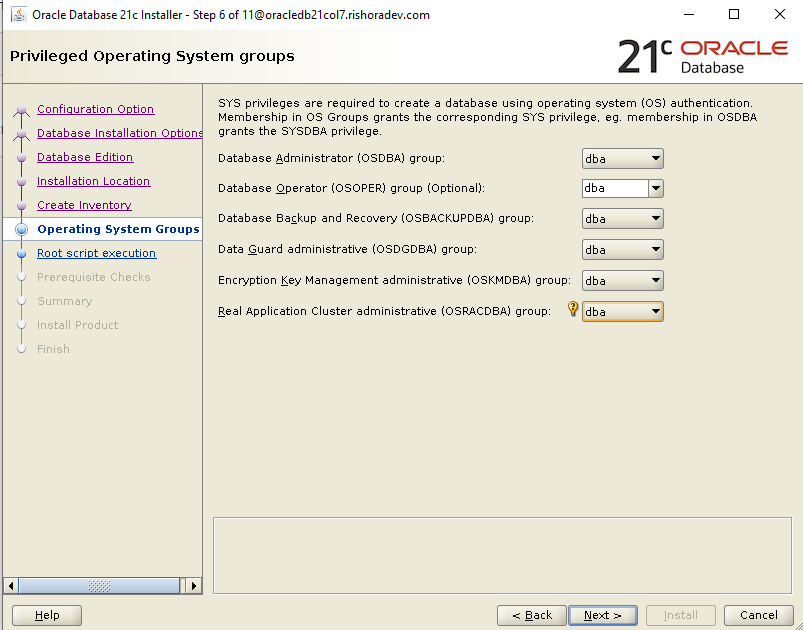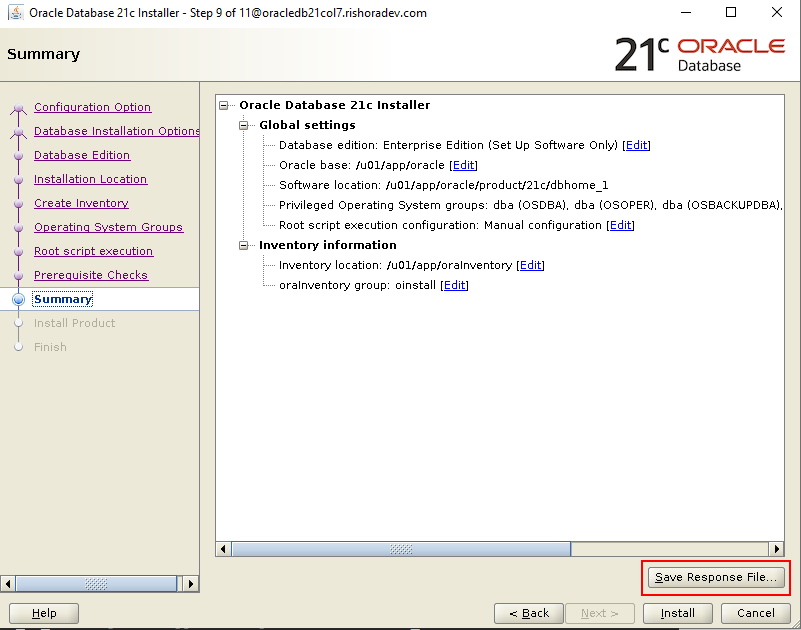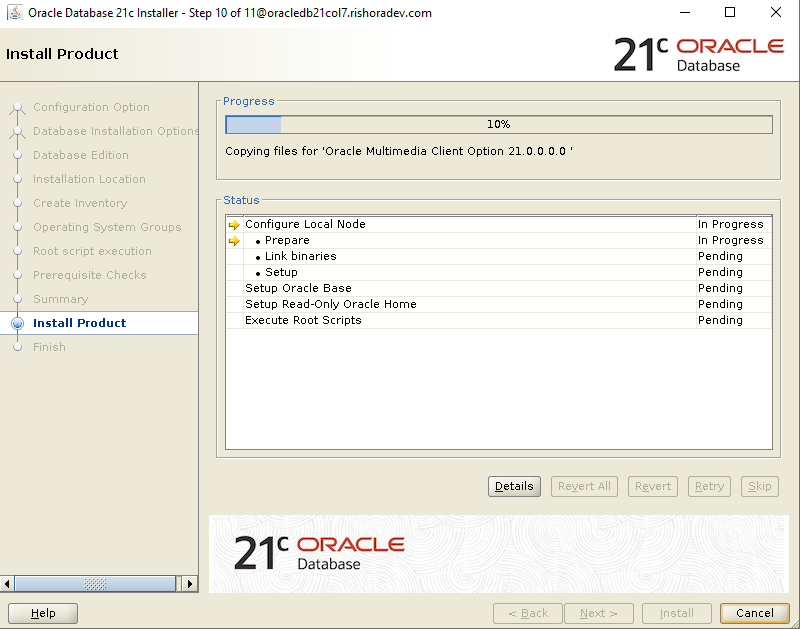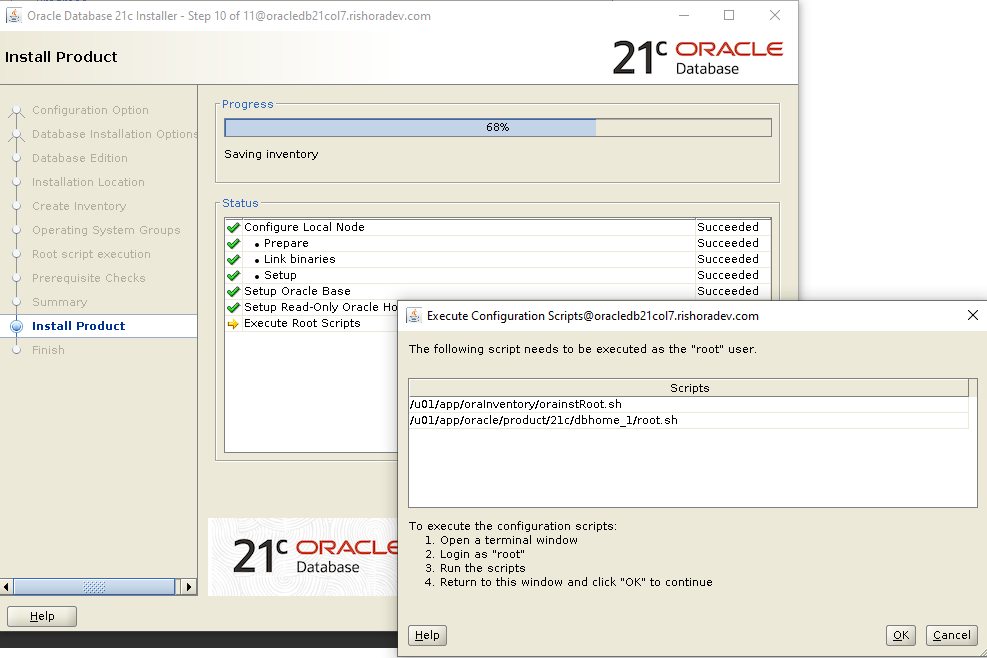Useful DBA Scripts
Script – Check RMAN Backup Status
Scripts to check backup status and timings of database backups –
This script will be run in the database, not the catalog.
Login as sysdba –
This script will report on all backups – full, incremental and archivelog backups –
col STATUS format a9
col hrs format 999.99
select
SESSION_KEY, INPUT_TYPE, STATUS,
to_char(START_TIME,'mm/dd/yy hh24:mi') start_time,
to_char(END_TIME,'mm/dd/yy hh24:mi') end_time,
elapsed_seconds/3600 hrs
from V$RMAN_BACKUP_JOB_DETAILS
order by session_key;
This script will report all on full and incremental backups, not archivelog backups –
col STATUS format a9
col hrs format 999.99
select
SESSION_KEY, INPUT_TYPE, STATUS,
to_char(START_TIME,'mm/dd/yy hh24:mi') start_time,
to_char(END_TIME,'mm/dd/yy hh24:mi') end_time,
elapsed_seconds/3600 hrs
from V$RMAN_BACKUP_JOB_DETAILS
where input_type='DB INCR'
order by session_key;
Scripts to check backup status and timings of database backups –
This script will be run in the database, not the catalog.
Login as sysdba –
This script will report on all backups – full, incremental and archivelog backups –
col STATUS format a9 col hrs format 999.99 select SESSION_KEY, INPUT_TYPE, STATUS, to_char(START_TIME,'mm/dd/yy hh24:mi') start_time, to_char(END_TIME,'mm/dd/yy hh24:mi') end_time, elapsed_seconds/3600 hrs from V$RMAN_BACKUP_JOB_DETAILS order by session_key;
This script will report all on full and incremental backups, not archivelog backups –
col STATUS format a9 col hrs format 999.99 select SESSION_KEY, INPUT_TYPE, STATUS, to_char(START_TIME,'mm/dd/yy hh24:mi') start_time, to_char(END_TIME,'mm/dd/yy hh24:mi') end_time, elapsed_seconds/3600 hrs from V$RMAN_BACKUP_JOB_DETAILS where input_type='DB INCR' order by session_key;
Script – Sessions with high physical reads
set linesize 120
col os_user format a10
col username format a15
col pid format 9999999999
PROMPT SESSIONS SORTED BY PHYSICAL READS
PROMPT
select
OSUSER os_user,username,
PROCESS pid,
ses.SID sid,
SERIAL#,
PHYSICAL_READS,
BLOCK_CHANGES
from v$session ses,
v$sess_io sio
where ses.SID = sio.SID
and username is not null
and status='ACTIVE'
order by PHYSICAL_READS;
set linesize 120
col os_user format a10
col username format a15
col pid format 9999999999
PROMPT SESSIONS SORTED BY PHYSICAL READS
PROMPT
select
OSUSER os_user,username,
PROCESS pid,
ses.SID sid,
SERIAL#,
PHYSICAL_READS,
BLOCK_CHANGES
from v$session ses,
v$sess_io sio
where ses.SID = sio.SID
and username is not null
and status='ACTIVE'
order by PHYSICAL_READS; |
Script – Database structure and file location
set pagesize 500
set linesize 130
Prompt
Prompt Control Files Location >>>>
col name format a60 heading "Control Files"
select name
from sys.v_$controlfile
/
Prompt
Prompt Redo Log File Locations >>>>
Prompt
col Grp format 9999
col member format a50 heading "Online REDO Logs"
col File# format 9999
col name format a50 heading "Online REDO Logs"
break on Grp
select group#,member
from sys.v_$logfile
/
Prompt Data Files Locations >>>>
col Tspace format a25
col status format a3 heading Sta
col Id format 9999
col Mbyte format 999999999
col name format a50 heading "Database Data Files"
col Reads format 99,999,999
col Writes format 99,999,999
break on report
compute sum label 'Total(MB)' of Mbyte on report
select F.file_id Id,
F.file_name name,
F.bytes/(1024*1024) Mbyte,
decode(F.status,'AVAILABLE','OK',F.status) status,
F.tablespace_name Tspace
from sys.dba_data_files F
order by tablespace_name;
Control Files Location >>>>
Control Files
------------------------------------------------------------
/u03/oradata/rcatp/control01.ctl
/u05/oradata/rcatp/control02.ctl
Redo Log File Locations >>>>
GROUP# Online REDO Logs
---------- --------------------------------------------------
1 /u03/oradata/rcatp/redo01.log
2 /u05/oradata/rcatp/redo02.log
3 /u03/oradata/rcatp/redo03.log
3 /u05/oradata/rcatp/redo03b.log
1 /u05/oradata/rcatp/redo01b.log
2 /u03/oradata/rcatp/redo02b.log
6 rows selected.
Data Files Locations >>>>
ID Database Data Files MBYTE Sta TSPACE
----- -------------------------------------------------- ---------- --- -------------------------
9 /u03/oradata/rcatp/patrol01.dbf 20 OK PATROL
7 /u03/oradata/rcatp/rman10p01.dbf 466 OK RMAN10P
5 /u03/oradata/rcatp/rman11p01.dbf 200 OK RMAN11P
8 /u03/oradata/rcatp/rman9p01.dbf 106 OK RMAN9P
3 /u03/oradata/rcatp/sysaux01.dbf 540 OK SYSAUX
1 /u03/oradata/rcatp/system01.dbf 700 OK SYSTEM
2 /u03/oradata/rcatp/undotbs01.dbf 220 OK UNDOTBS1
4 /u03/oradata/rcatp/users01.dbf 6 OK USERS
----------
sum 2258
8 rows selected.
set pagesize 500
set linesize 130
Prompt
Prompt Control Files Location >>>>
col name format a60 heading "Control Files"
select name
from sys.v_$controlfile
/
Prompt
Prompt Redo Log File Locations >>>>
Prompt
col Grp format 9999
col member format a50 heading "Online REDO Logs"
col File# format 9999
col name format a50 heading "Online REDO Logs"
break on Grp
select group#,member
from sys.v_$logfile
/
Prompt Data Files Locations >>>>
col Tspace format a25
col status format a3 heading Sta
col Id format 9999
col Mbyte format 999999999
col name format a50 heading "Database Data Files"
col Reads format 99,999,999
col Writes format 99,999,999
break on report
compute sum label 'Total(MB)' of Mbyte on report
select F.file_id Id,
F.file_name name,
F.bytes/(1024*1024) Mbyte,
decode(F.status,'AVAILABLE','OK',F.status) status,
F.tablespace_name Tspace
from sys.dba_data_files F
order by tablespace_name;
Control Files Location >>>>
Control Files
------------------------------------------------------------
/u03/oradata/rcatp/control01.ctl
/u05/oradata/rcatp/control02.ctl
Redo Log File Locations >>>>
GROUP# Online REDO Logs
---------- --------------------------------------------------
1 /u03/oradata/rcatp/redo01.log
2 /u05/oradata/rcatp/redo02.log
3 /u03/oradata/rcatp/redo03.log
3 /u05/oradata/rcatp/redo03b.log
1 /u05/oradata/rcatp/redo01b.log
2 /u03/oradata/rcatp/redo02b.log
6 rows selected.
Data Files Locations >>>>
ID Database Data Files MBYTE Sta TSPACE
----- -------------------------------------------------- ---------- --- -------------------------
9 /u03/oradata/rcatp/patrol01.dbf 20 OK PATROL
7 /u03/oradata/rcatp/rman10p01.dbf 466 OK RMAN10P
5 /u03/oradata/rcatp/rman11p01.dbf 200 OK RMAN11P
8 /u03/oradata/rcatp/rman9p01.dbf 106 OK RMAN9P
3 /u03/oradata/rcatp/sysaux01.dbf 540 OK SYSAUX
1 /u03/oradata/rcatp/system01.dbf 700 OK SYSTEM
2 /u03/oradata/rcatp/undotbs01.dbf 220 OK UNDOTBS1
4 /u03/oradata/rcatp/users01.dbf 6 OK USERS
----------
sum 2258
8 rows selected.ASH and AWR Performance Tuning Scripts
Listed below are some SQL queries which I find particularly useful for performance tuning. These are based on the Active Session History V$ View to get a current perspective of performance and the DBA_HIST_* AWR history tables for obtaining performance data pertaining to a period of time in the past.
Top Recent Wait Events
col EVENT format a60 select * from ( select active_session_history.event, sum(active_session_history.wait_time + active_session_history.time_waited) ttl_wait_time from v$active_session_history active_session_history where active_session_history.event is not null group by active_session_history.event order by 2 desc) where rownum < 6 /
Top Wait Events Since Instance Startup
col event format a60 select event, total_waits, time_waited from v$system_event e, v$event_name n where n.event_id = e.event_id and n.wait_class !='Idle' and n.wait_class = (select wait_class from v$session_wait_class where wait_class !='Idle' group by wait_class having sum(time_waited) = (select max(sum(time_waited)) from v$session_wait_class where wait_class !='Idle' group by (wait_class))) order by 3;
List Of Users Currently Waiting
col username format a12 col sid format 9999 col state format a15 col event format a50 col wait_time format 99999999 set pagesize 100 set linesize 120 select s.sid, s.username, se.event, se.state, se.wait_time from v$session s, v$session_wait se where s.sid=se.sid and se.event not like 'SQL*Net%' and se.event not like '%rdbms%' and s.username is not null order by se.wait_time;
Find The Main Database Wait Events In A Particular Time Interval
First determine the snapshot id values for the period in question.
In this example we need to find the SNAP_ID for the period 10 PM to 11 PM on the 14th of November, 2012.
select snap_id,begin_interval_time,end_interval_time from dba_hist_snapshot where to_char(begin_interval_time,'DD-MON-YYYY')='14-NOV-2012' and EXTRACT(HOUR FROM begin_interval_time) between 22 and 23;
set verify off
select * from (
select active_session_history.event,
sum(active_session_history.wait_time +
active_session_history.time_waited) ttl_wait_time
from dba_hist_active_sess_history active_session_history
where event is not null
and SNAP_ID between &ssnapid and &esnapid
group by active_session_history.event
order by 2 desc)
where rownum
Top CPU Consuming SQL During A Certain Time Period
Note – in this case we are finding the Top 5 CPU intensive SQL statements executed between 9.00 AM and 11.00 AM
select * from ( select SQL_ID, sum(CPU_TIME_DELTA), sum(DISK_READS_DELTA), count(*) from DBA_HIST_SQLSTAT a, dba_hist_snapshot s where s.snap_id = a.snap_id and s.begin_interval_time > sysdate -1 and EXTRACT(HOUR FROM S.END_INTERVAL_TIME) between 9 and 11 group by SQL_ID order by sum(CPU_TIME_DELTA) desc) where rownum
Which Database Objects Experienced the Most Number of Waits in the Past One Hour
set linesize 120
col event format a40
col object_name format a40
select * from
(
select dba_objects.object_name,
dba_objects.object_type,
active_session_history.event,
sum(active_session_history.wait_time +
active_session_history.time_waited) ttl_wait_time
from v$active_session_history active_session_history,
dba_objects
where
active_session_history.sample_time between sysdate - 1/24 and sysdate
and active_session_history.current_obj# = dba_objects.object_id
group by dba_objects.object_name, dba_objects.object_type, active_session_history.event
order by 4 desc)
where rownum < 6;Top Segments ordered by Physical Reads
col segment_name format a20
col owner format a10
select segment_name,object_type,total_physical_reads
from ( select owner||'.'||object_name as segment_name,object_type,
value as total_physical_reads
from v$segment_statistics
where statistic_name in ('physical reads')
order by total_physical_reads desc)
where rownumTop 5 SQL statements in the past one hour
select * from ( select active_session_history.sql_id, dba_users.username, sqlarea.sql_text, sum(active_session_history.wait_time + active_session_history.time_waited) ttl_wait_time from v$active_session_history active_session_history, v$sqlarea sqlarea, dba_users where active_session_history.sample_time between sysdate - 1/24 and sysdate and active_session_history.sql_id = sqlarea.sql_id and active_session_history.user_id = dba_users.user_id group by active_session_history.sql_id,sqlarea.sql_text, dba_users.username order by 4 desc ) where rownum
SQL with the highest I/O in the past one day
select * from
(
SELECT /*+LEADING(x h) USE_NL(h)*/
h.sql_id
, SUM(10) ash_secs
FROM dba_hist_snapshot x
, dba_hist_active_sess_history h
WHERE x.begin_interval_time > sysdate -1
AND h.SNAP_id = X.SNAP_id
AND h.dbid = x.dbid
AND h.instance_number = x.instance_number
AND h.event in ('db file sequential read','db file scattered read')
GROUP BY h.sql_id
ORDER BY ash_secs desc )
where rownumTop CPU consuming queries since past one day
select * from ( select SQL_ID, sum(CPU_TIME_DELTA), sum(DISK_READS_DELTA), count(*) from DBA_HIST_SQLSTAT a, dba_hist_snapshot s where s.snap_id = a.snap_id and s.begin_interval_time > sysdate -1 group by SQL_ID order by sum(CPU_TIME_DELTA) desc) where rownum
Find what the top SQL was at a particular reported time of day
First determine the snapshot id values for the period in question.
In thos example we need to find the SNAP_ID for the period 10 PM to 11 PM on the 14th of November, 2012.
select snap_id,begin_interval_time,end_interval_time from dba_hist_snapshot where to_char(begin_interval_time,'DD-MON-YYYY')='14-NOV-2012' and EXTRACT(HOUR FROM begin_interval_time) between 22 and 23;
select * from ( select sql.sql_id c1, sql.buffer_gets_delta c2, sql.disk_reads_delta c3, sql.iowait_delta c4 from dba_hist_sqlstat sql, dba_hist_snapshot s where s.snap_id = sql.snap_id and s.snap_id= &snapid order by c3 desc) where rownum < 6 /
Analyse a particular SQL ID and see the trends for the past day
select s.snap_id, to_char(s.begin_interval_time,'HH24:MI') c1, sql.executions_delta c2, sql.buffer_gets_delta c3, sql.disk_reads_delta c4, sql.iowait_delta c5, sql.cpu_time_delta c6, sql.elapsed_time_delta c7 from dba_hist_sqlstat sql, dba_hist_snapshot s where s.snap_id = sql.snap_id and s.begin_interval_time > sysdate -1 and sql.sql_id='&sqlid' order by c7 /
Do we have multiple plan hash values for the same SQL ID – in that case may be changed plan is causing bad performance
select SQL_ID , PLAN_HASH_VALUE , sum(EXECUTIONS_DELTA) EXECUTIONS , sum(ROWS_PROCESSED_DELTA) CROWS , trunc(sum(CPU_TIME_DELTA)/1000000/60) CPU_MINS , trunc(sum(ELAPSED_TIME_DELTA)/1000000/60) ELA_MINS from DBA_HIST_SQLSTAT where SQL_ID in ( '&sqlid') group by SQL_ID , PLAN_HASH_VALUE order by SQL_ID, CPU_MINS;
Top 5 Queries for past week based on ADDM recommendations
/* Top 10 SQL_ID's for the last 7 days as identified by ADDM from DBA_ADVISOR_RECOMMENDATIONS and dba_advisor_log */ col SQL_ID form a16 col Benefit form 9999999999999 select * from ( select b.ATTR1 as SQL_ID, max(a.BENEFIT) as "Benefit" from DBA_ADVISOR_RECOMMENDATIONS a, DBA_ADVISOR_OBJECTS b where a.REC_ID = b.OBJECT_ID and a.TASK_ID = b.TASK_ID and a.TASK_ID in (select distinct b.task_id from dba_hist_snapshot a, dba_advisor_tasks b, dba_advisor_log l where a.begin_interval_time > sysdate - 7 and a.dbid = (select dbid from v$database) and a.INSTANCE_NUMBER = (select INSTANCE_NUMBER from v$instance) and to_char(a.begin_interval_time, 'yyyymmddHH24') = to_char(b.created, 'yyyymmddHH24') and b.advisor_name = 'ADDM' and b.task_id = l.task_id and l.status = 'COMPLETED') and length(b.ATTR4) > 1 group by b.ATTR1 order by max(a.BENEFIT) desc) where rownum < 6;





